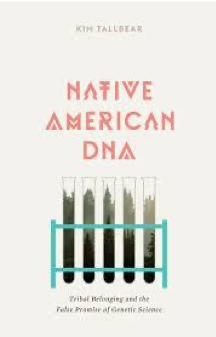
Kim TallBear
Native American DNA: Tribal Belonging and the False Promise of Genetic Science
University of Minnesota Press, 2013
256 pages
$25.00
Reviewed by Emily Harring
In 2018, senator Elizabeth Warren underwent a DNA test to “prove” the indigenous ancestry she has claimed for decades (a move she thought would aid her presidential campaign but has since proven to have done more harm than good––particularly amongst Native voters). Tribal leaders and citizens spoke out against this move, reiterating that Native kinship has nothing to do with DNA testing and blood quantum and everything with tribal affiliation and kinship. This conversation has been ongoing for years, growing in popularity since the release of Native American DNA by Sisseton Wahpeton Oyate scholar Kim TallBear. Though written in 2013, TallBear’s book remains relevant, echoing and exploring the need for settler recognition of Indigenous self-determination and agency, topics that outside of the academy tribes and nations continue to advocate for.
TallBear makes it apparent to the reader that her book uses multiple disciplines to frame her argument, its assemblage one that appeals to readers from different fields (anthropology, Indigenous studies, and many others). Her methodology in Native American DNA moves through “multiple disciplinary, national, and ethnic cultural spaces” and “hybrid writing styles that enable self-reflexivity and polyvocality in ethnography.” This ethnography follows that of other Native scholars (such as Kahnawake Mohawk scholar Audra Simpson in her monograph Mohawk Interruptus). In light of the book’s roots in an indigenous writing methodology, it is noteworthy that Tallbear makes the decision to include only a few interviews from Indian Country. She writes, “Putting that informed-consent form between me and other tribal members felt wrong, like making an object of Indian Country rather than ‘routing’ me in and through it. I could not bring myself to write about my fellow tribal citizens, our family histories having been entwined for centuries, especially if that writing took place largely outside a shared or community-based project.” Thus, the project is not about Native perspectives on DNA or blood and their roles in forming Indigenous citizenship; rather, it positions its gaze to non-Native subjects.
The first chapter, “Racial Science, Blood, and DNA,” introduces the history behind the correlation of blood, DNA, and tribal enrollment. TallBear moves effectively and efficiently through the beginnings of racial science in the nineteenth century and how it carried through the twentieth century, ultimately leading to racial categorization in the US’s laws and politics. From this, TallBear moves to a discussion on genetics, laying out for the reader what makes DNA and how these genetic markers came to be used as evidence of one’s Native ancestry. While the scientific jargon behind these genetic markers could have easily become overwhelming for readers, TallBear moves through it clearly, taking the time to explain in multiple ways what the science means regarding tribal enrollment of the past and present. Ultimately, this chapter asks: Why do concepts of blood still permeate throughout discourses on race and identity––especially in regard to Native peoples––when it is no longer “fashionable” in government policies? Blood acted as a symbol for inheritance, deciding who is allowed to inherit, sell, or buy land. Blood, then, became one’s identity, and continues to be seen as such in our present day. Historically, settler colonists aimed to dilute Native culture (and ‘blood’) in order to eventually take their land, while simultaneously desiring to possess their own drop of Native blood––a central component “to constructing moral legitimacy and a uniquely American identity.” TallBear ends the chapter noting how “tribes have increasingly moved away from the racial mechanism of total ‘Indian blood’ to a genealogical mechanism of ‘tribe-specific blood’,” making DNA or ancestry tests incompatible with tribal enrollment.
Once TallBear has established the necessary history behind her argument, she then shifts her attention to the DNA-testing companies, providing textual analyses of their practices and advertising strategies. She focuses on six companies: DNAPrint Genomics, DNAToday, Genelex, GeneTree, Niagen, and Orchid Cellmark, examining their work “in relation to two categories of conceptual and social organization, ‘race’ and ‘tribe,’ that are fundamental to how Native American history and identity gets understood and regulated.” TallBear questions whether or not DNA testing will cause more racialization of Native Americans through its promotion of the notion that “the tribe is a genetic population” rather than one of tribal kinship and lineage. Readers interested in learning more about the rise of genealogical research in online communities may find “Genetic Genealogy Online” compelling as Tallbear studies one Listserv in particular, corresponding with individual ‘listers’ and thousands of posts. TallBear ends the book looking at The Genographic Project, which aimed to trace the history of human’s global migration, an attempt to argue that we are all related, genetically. She explores how this project may or may not lead to a genetic (re)articulation of indigeneity.
Native American DNA is a well-crafted, well researched book unpacking the issues surrounding racial science, DNA, and tribal sovereignty and self-determination. It is critical to its field, a must read for those who study Indigeneity––in all fields. As we see in the case of Senator Warren, conversations surrounding the illegitimacy of DNA tests to determine Native belonging are not over, as this testing and its results still remain popular.


